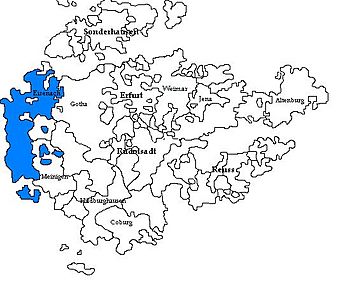Saxe-Eisenach facts for kids
Quick facts for kids
Duchy of Saxe-Eisenach
Herzogtum Sachsen-Eisenach
|
|||||||||||||||||||
|---|---|---|---|---|---|---|---|---|---|---|---|---|---|---|---|---|---|---|---|
| 1596 – 1638 1640 – 1644 1672 – 1809 |
|||||||||||||||||||

Saxe-Eisenach, shown amongst the other 18th-century Ernestine duchies
|
|||||||||||||||||||
| Status | State of the Holy Roman Empire State of the Confederation of the Rhine |
||||||||||||||||||
| Capital | Eisenach | ||||||||||||||||||
| Government | Principality | ||||||||||||||||||
| Historical era | Middle Ages | ||||||||||||||||||
|
• Division of Erfurt
|
1572 | ||||||||||||||||||
|
• Partitioned from
Saxe-Coburg-Eisenach |
1596 1596 |
||||||||||||||||||
| 1638 |
|||||||||||||||||||
|
• Partitioned from Weimar
|
1640 | ||||||||||||||||||
| 1644 |
|||||||||||||||||||
|
• Partitioned from Weimar
|
1662 | ||||||||||||||||||
| 1741 1809 | |||||||||||||||||||
|
• Merged to form
Saxe-Weimar-Eisenach |
1809 |
||||||||||||||||||
|
|||||||||||||||||||
Saxe-Eisenach (pronounced "Saks-EYE-zen-akh") was the name for three different small states in a region called Thuringia, which is now part of Germany. These states were known as Ernestine duchies. A duchy is a territory ruled by a duke or duchess. The main city and capital for all three of these states was Eisenach.
History of Saxe-Eisenach
The history of Saxe-Eisenach is a bit like a puzzle, with the territory being created, split, and reunited several times. It was part of the Holy Roman Empire, a large group of states in Central Europe.
First Saxe-Eisenach (1596–1638)
The first Duchy of Saxe-Eisenach started in 1596. It was created for a young duke named Johann Ernst. He was the younger son of Johann Frederick II. Before this, the area was part of a larger state called Saxe-Coburg-Eisenach.
In 1633, the family line that ruled Saxe-Coburg died out. Johann Ernst inherited their lands. However, he passed away in 1638 without any children to take over. Because of this, his lands, including Saxe-Eisenach, were divided. They were split between two other duchies: Saxe-Weimar and Saxe-Altenburg.
Second Saxe-Eisenach (1640–1644)
Just two years later, in 1640, Saxe-Eisenach was created again. This time, it was separated from Saxe-Weimar. The new duke was Albert, who was the son of John II of Saxe-Weimar.
However, Duke Albert also died without children after only four years, in 1644. So, Saxe-Eisenach was divided once more. Its lands were split between his brothers, Ernst (who ruled Saxe-Gotha) and Wilhelm (who ruled Saxe-Weimar).
Third Saxe-Eisenach (1662–1809)
The third and longest-lasting version of Saxe-Eisenach began in 1662. This happened after Wilhelm, Duke of Saxe-Weimar died. He had four sons, and one of them, Adolf Wilhelm, received Eisenach.
Adolf Wilhelm had to share the rule with his younger brother, Johann Georg. Eventually, Johann Georg decided to take money from the duchy instead of helping to govern it. He moved to a smaller town called Marksuhl.
Sadly, Adolf Wilhelm's first four sons died very young. He himself passed away in 1668, just before his fifth child, Wilhelm August, was born. Wilhelm August became the new Duke of Saxe-Eisenach from birth. His uncle, Johann Georg, acted as his regent, meaning he ruled on behalf of the young duke. Wilhelm August was a sickly child and died in 1671 at only two years old. After his death, Johann Georg I became the official Duke of Saxe-Eisenach.
Saxe-Eisenach changed its borders again in 1672. This was because Frederick William III of Saxe-Altenburg died, and his lands were divided. The family line of Johann Georg I ruled Saxe-Eisenach for 69 years.
Union with Saxe-Weimar
In 1741, Duke Wilhelm Heinrich died without any children. This meant his family line ended. His second cousin, Ernst August I of Saxe-Weimar, inherited Saxe-Eisenach.
From 1741, Ernst August I and the dukes who came after him ruled both Saxe-Weimar and Saxe-Eisenach. This was called a "personal union." It meant the two duchies had the same ruler but were still separate states. This arrangement continued until 1809. In that year, the two duchies were officially combined to form a new, larger state called the Duchy of Saxe-Weimar-Eisenach.
Dukes of Saxe-Eisenach
Here are the dukes who ruled Saxe-Eisenach during its different periods.
First Creation (1596–1638)
- Johann Ernst (1596 – 1638)
- After Johann Ernst died, the land was divided between Saxe-Altenburg and Saxe-Weimar.
Second Creation (1640–1644)
- Albrecht (1640 – 1644)
- After Albrecht died, the land was divided between Saxe-Gotha and Saxe-Weimar.
Third Creation (1662–1741)
- Adolf Wilhelm (1662 – 1668)
- Wilhelm August (1668 – 1671)
- Johann Georg I (1671 – 1686)
- Johann Georg II (1686 – 1698)
- Johann Wilhelm (1698 – 1729)
- Wilhelm Heinrich (1729 – 1741)
- This family line ended when Wilhelm Heinrich died without children.
Dukes in Personal Union with Saxe-Weimar (1741–1809)
These dukes ruled both Saxe-Weimar and Saxe-Eisenach at the same time.
- Ernst August I (1741 – 1748)
- Ernst August II (1748 – 1758)
- Karl August (1758 – 1809)
- In 1809, Saxe-Eisenach officially joined with Saxe-Weimar to form Saxe-Weimar-Eisenach.
Images for kids
Related pages
See also
 In Spanish: Ducado de Sajonia-Eisenach para niños
In Spanish: Ducado de Sajonia-Eisenach para niños


